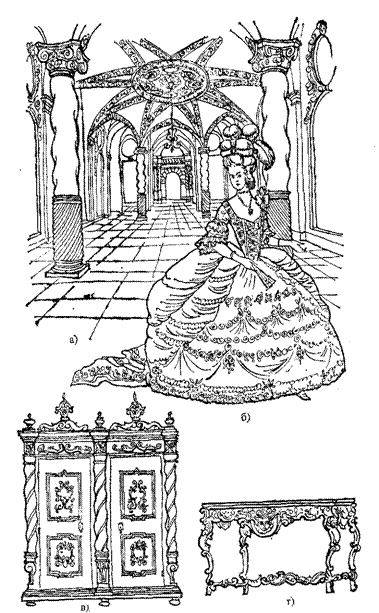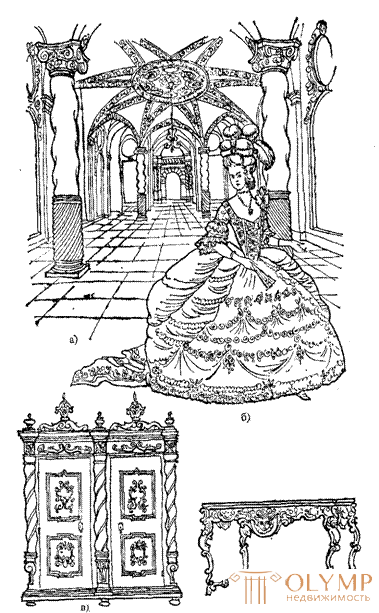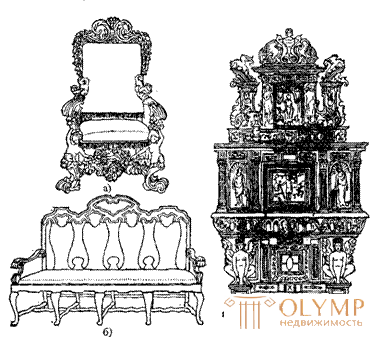
In place of the Renaissance at the end of the XVI century. A new baroque style came (Italian. Barocco, literally - strange, whimsical), which dominated in Europe until the middle of the XVIII century. Baroque is associated with the noble-church culture of mature absolutism. Baroque is characterized by contrast, the desire for greatness and pomp (Fig. 1). Interiors are particularly luxurious. Widely used sculpture, sculpture, painting. Premises trimmed with expensive materials! marble and gilding. The internal space of the premises is visually increased due to the introduction of the illusory space of the painted shades.
Also make out the furniture magnificently. Consoles (wall tables), benches, tables, chairs and bureau offices have a large variety of forms (Fig. 2).
In the technology of making furniture in the Baroque era, veneering and wood set technology are becoming the main methods of decoration.
Seating furniture becomes more comfortable: soft seats, backrests with a blade, comfortable armrests appear in the chairs (Fig. 2, a, b). At the same time, the plastic solution of furniture products and their diversity becomes more complicated. Baroque armchairs are equipped with straight and tapered legs with a jug-shaped extension at the top and curved. But in almost all cases, the chairs are massive, decorated with carvings and equipped with a progron or slightly curved crosspiece with a carved pot in the middle. Upholstered furniture upholstered in dark velvet with a large pattern.

Fig. 1. Baroque style in architectural and substantive environment

Fig. 2. Furniture of Italian Baroque: a - a chair, b - a sofa, a - a wardrobe
Stools are made with diverging, curving legs, which have curved prone progresses and gilded relief threads.
Chests and chests, which by this time began to resemble ancient sarcophagi in form, give way to cupboards (Fig. 2, c), offices and bureau offices. The cabinets are characterized by curvilinear outlines in the plan, the presence of a curved cornice with a complex sculptural composition, a complex silhouette.
Cabinets were made not only floor-standing with legs, but also desk and miniature boxes of equal size. Especially famous were the offices of Florence, which were trimmed with ebony, ivory, mother of pearl, earthenware, gilded bronze details. For their decoration, the technique of Florentine mosaic was often used: images of birds, flowers were laid out on a tree from thin sections of stones.
The stelae had a six or octagonal shape; the edges of the tabletops were processed in various ways, using carved ornamentation. The legs used during the Renaissance period in the form of massive supports are replaced by one turned into a vase, to which are attached on three sides special brackets, ending at the bottom with animal paws. All this base stands on a massive basis, also completely covered with carvings.
Fundamental changes occur in the design of the bed: there is a canopy that cantileverly fastens to the wall, but the tall columns supporting it disappear. Thus, the volume of the bed is visually included in the space of the room.
Furniture products are decorated with new materials: bone, tortoise shell, mother of pearl, porcelain, etc .; countertops and face surfaces - marquetry and stone mosaic.
Baroque furniture art is the most developed in the north of Italy. Especially known furniture of Venice, it was distinguished by bright murals and varnishes. Venetian chairs are characterized by complexity of forms, lack of articulation and rich decoration.
Along with the Venetian Florentine and Bologna schools develop. The classrooms of the Bologna school, also of ebony, had underframes with legs in the form of twisted columns, the front surface of the cabinet was treated like a facade of a stone building: cornices, traction and profiles. Often, these cabinets were completed in the form of a parapet, which is topped with a balustrade decorated with statuettes of bone.
Что бы оставить комментарий войдите
Комментарии (0)